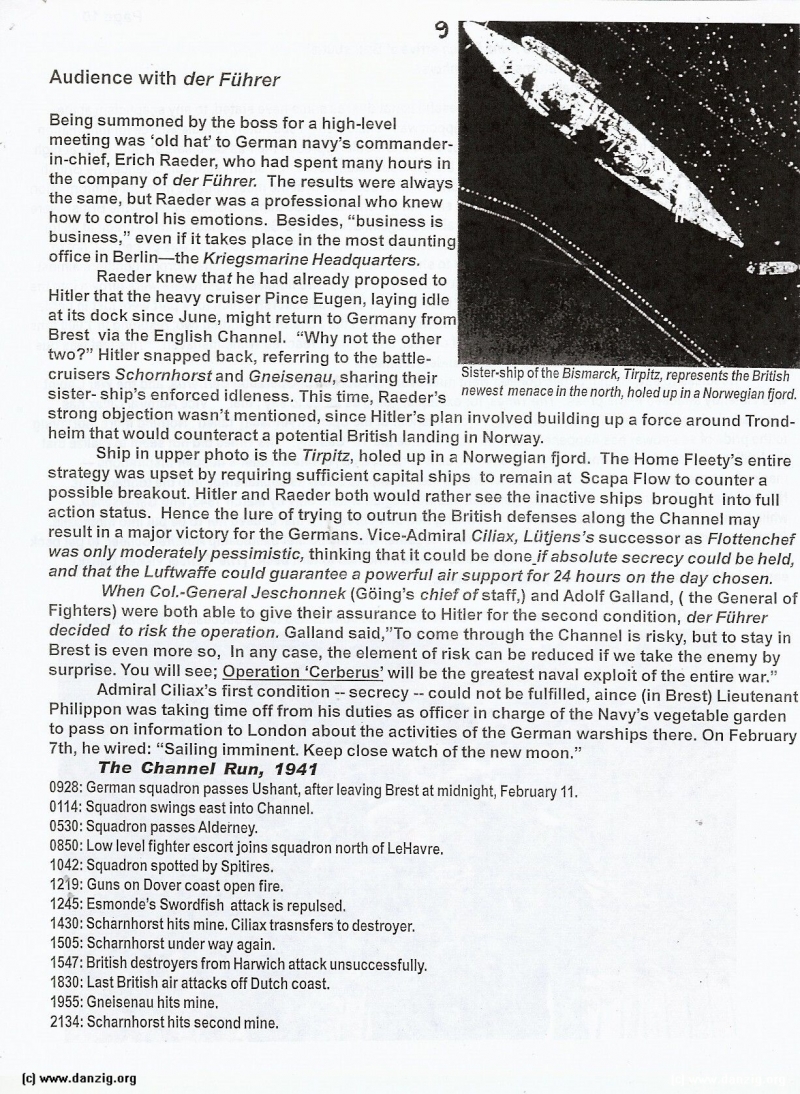
Audience with der Führer
Being summoned by the boss for a high-level meeting was ‘old hat’ to German navy’s commander- in-chief, Erich Raeder, who had spent many hours in the company of der Führer. The results were always the same, but Raeder was a professional who knew how to control his emotions. Besides, “business is business,” even if it takes place in the most daunting office in Berlin—the Kriegsmarine Headquarters.
Raeder knew that he had already proposed to Hitler that the heavy cruiser Pince Eugen, laying idle at its dock since June, might return to Germany from Brest via the English Channel. “Why not the other two?” Hitler snapped back, referring to the battle cruisers Schornhorst and Gneisenau, sharing their Sister ship of the Bismarck, Tirpitz. represents the British sister- ship’s enforced idleness. This time, Raeder’s newest menace in the north, holed up in a Norwegian fjord. strong objection wasn’t mentioned, since Hitler’s plan involved building up a force around Trondheim that would counteract a potential British landing in Norway.
Ship in upper photo is the Tirpitz, holed up in a Norwegian fjord. The Home Fleety’s entire strategy was upset by requiring sufficient capital ships to remain at Scapa Flow to counter a possible breakout. Hitler and Raeder both would rather see the inactive ships brought into full action status. Hence the lure of trying to outrun the British defenses along the Channel may result in a major victory for the Germans. Vice-Admiral Ciliax, Lütjens’s successor as Flottenchef was only moderately pessimistic, thinking that it could be done if absolute secrecy could be held, and that the Luftwaffe could guarantee a powerful air support for 24 hours on the day chosen.
When Col.-General Jeschonnek (Going’s chief of staff,) and Adolf Galland, (the General of Fighters) were both able to give their assurance to Hitler for the second condition, der Führer decided to risk the operation. Galland said,”To come through the Channel is risky, but to stay in Brest is even more so, In any case, the element of risk can be reduced if we take the enemy by surprise. You will see; Operation ‘Cerberus’ will be the greatest naval exploit of the entire war.”
Admiral Ciliax’s first condition -- secrecy -- could not be fulfilled, aince (in Brest) Lieutenant Philippon was taking time off from his duties as officer in charge of the Navy’s vegetable garden to pass on information to London about the activities of the German warships there. On February 7th, he wired: “Sailing imminent. Keep close watch of the new moon.”
The Channel Run, 1941
0928: German squadron passes Ushant, after leaving Brest at midnight, February 11.
0114: Squadron swings east into Channel.
0530: Squadron passes Alderney.
0850: Low level fighter escort joins squadron north of Le Havre.
1042: Squadron spotted by Spitfires.
1219: Guns on Dover coast open fire.
1245: Esmonde’s Swordfish attack is repulsed.
1430: Scharnhorst hits mine. Ciliax transfers to destroyer.
1505: Scharnhorst underway again.
1547: British destroyers from Harwich attack unsuccessfully.
1830: Last British air attacks off Dutch coast.
1955: Gneisenau hits mine.
2134: Scharnhorst hits second mine.
Danzig Report Nr. 159 - 1st Quarter 2013, Page 9.
Hits: 3878
Added: 12/08/2015
Copyright: 2025 Danzig.org

